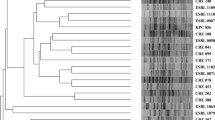Abstract
The inhibitory and bactericidal activity of N-formimidoyl-thienamycin in vitro against 131 clinical isolates selected for their gentamicin resistance was compared with that of cefotaxime and moxalactam. All strains were inhibited by N-formimidoyl-thienamycin concentrations within a range of 0.12–4 mg/l. N-formimidoyl-thienamycin was less active than cefotaxime and moxalactam againstEscherichia coli andKlebsiella spp., and more active than all other antibiotics tested againstSerratia spp.,Enterobacter cloacae, Pseudomonas aeruginosa andAcinetobacter spp. In contrast to the other antibiotics N-formimidoyl-thienamycin showed a narrow margin of difference between minimal inhibitory and minimal bactericidal concentrations. N-formimidoyl-thienamycin is a promising antibiotic for the treatment of hospital infections with multi-resistant organisms.
Similar content being viewed by others
References
Wildonger, K. J., Leanza, W. J., Miller, T. W., Christensen, B. G.: N-acetimidoyl and N-formimidoyl-thienamycin, chemically stable, broad spectrum derivatives. 11th International Congress of Chemotherapy/19th Interscience Conference of Antimicrobial Agents and Chemotherapy, Boston 1979, Abstract 232.
Tutlane, V. A., McCloskey, R. V., Trent, J. A.: In vitro comparison of N-formimidoyl thienamycin, piperacillin, cefotaxime, and cefoperazone. Antimicrobial Agents and Chemotherapy 1981, 20: 140–143.
Verbist, L., Verhaegen, J.: In vitro activity of N-formimidoyl thienamycin in comparison with cefotaxime, moxalactam, and ceftazidime. Antimicrobial Agents and Chemotherapy 1981, 19: 402–406.
Wise, R., Andrews, J. M., Patel, N.: N-formimidoy-lthienamycin a novelβ-lactam: an in-vitro comparison with otherβ-lactam antibiotics. Journal of Antimicrobial Chemotherapy 1981, 7: 521–529.
Richmond, M. H.: The semi-synthetic thienamycin derivative MKO787 and its properties with respect to a range ofβ-lactamases from clinically relevant bacterial species. Journal of Antimicrobial Chemotherapy 1981, 7: 279–285.
Toda, M., Sato, K., Nakazawa, H., Inoue, M., Mitsuhashi, S.: Effect of N-formimidoyl thienamycin (MKO787) onβ-lactamases and activity againstβ-lactamase-producting strains. Antimicrobial Agents and Chemotherapy 1980, 18: 837–838.
Smith, S., May, R. S.: N-formimidoyl thienamycin (MKO787): in vitro study. Antimicrobial Agents and Chemotherapy 1981, 19: 201–204.
Hanslo, D., King, A., Shannon, K., Warren, Ch., Phillips, I.: N-formimidoyl thienamycin (MKO787): in-vitro antibacterial activity and susceptibility toβ-lactamases compared with that of cefotaxime, moxalactam and otherβ-lactam antibiotics. Journal of Antimicrobial Chemotherapy 1981, 7: 607–617.
Author information
Authors and Affiliations
Rights and permissions
About this article
Cite this article
Pusztai-Markos, Z., Pranada, F. In vitro activity of N-formimidoyl-thienamycin in comparison to that of moxalactam and cefotaxime against gentamicin-resistant gram-negative bacteria. Eur. J, Clin. Microbiol. 1, 49–51 (1982). https://doi.org/10.1007/BF02014140
Issue Date:
DOI: https://doi.org/10.1007/BF02014140




